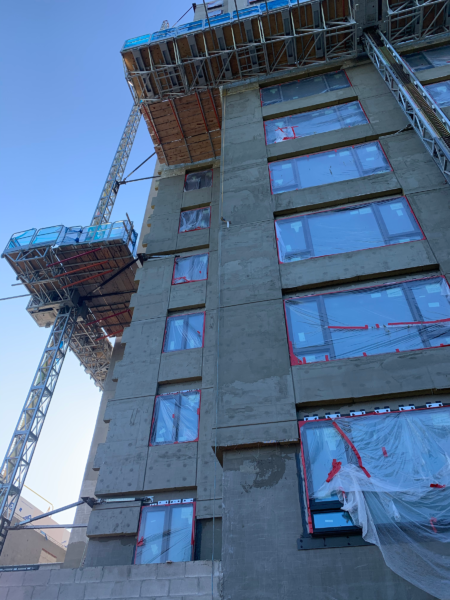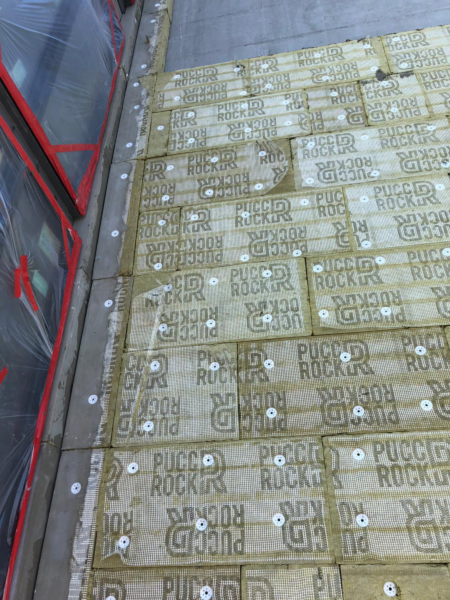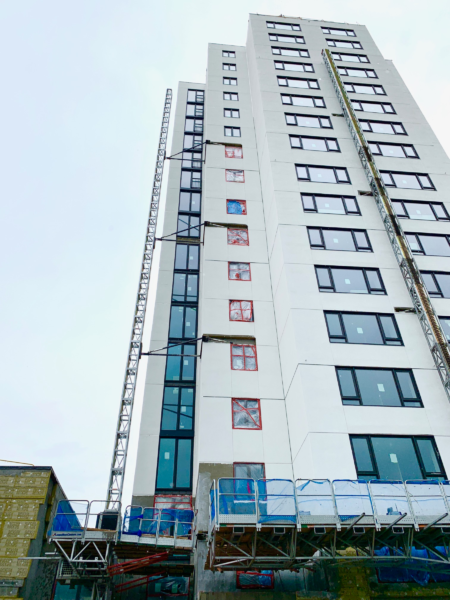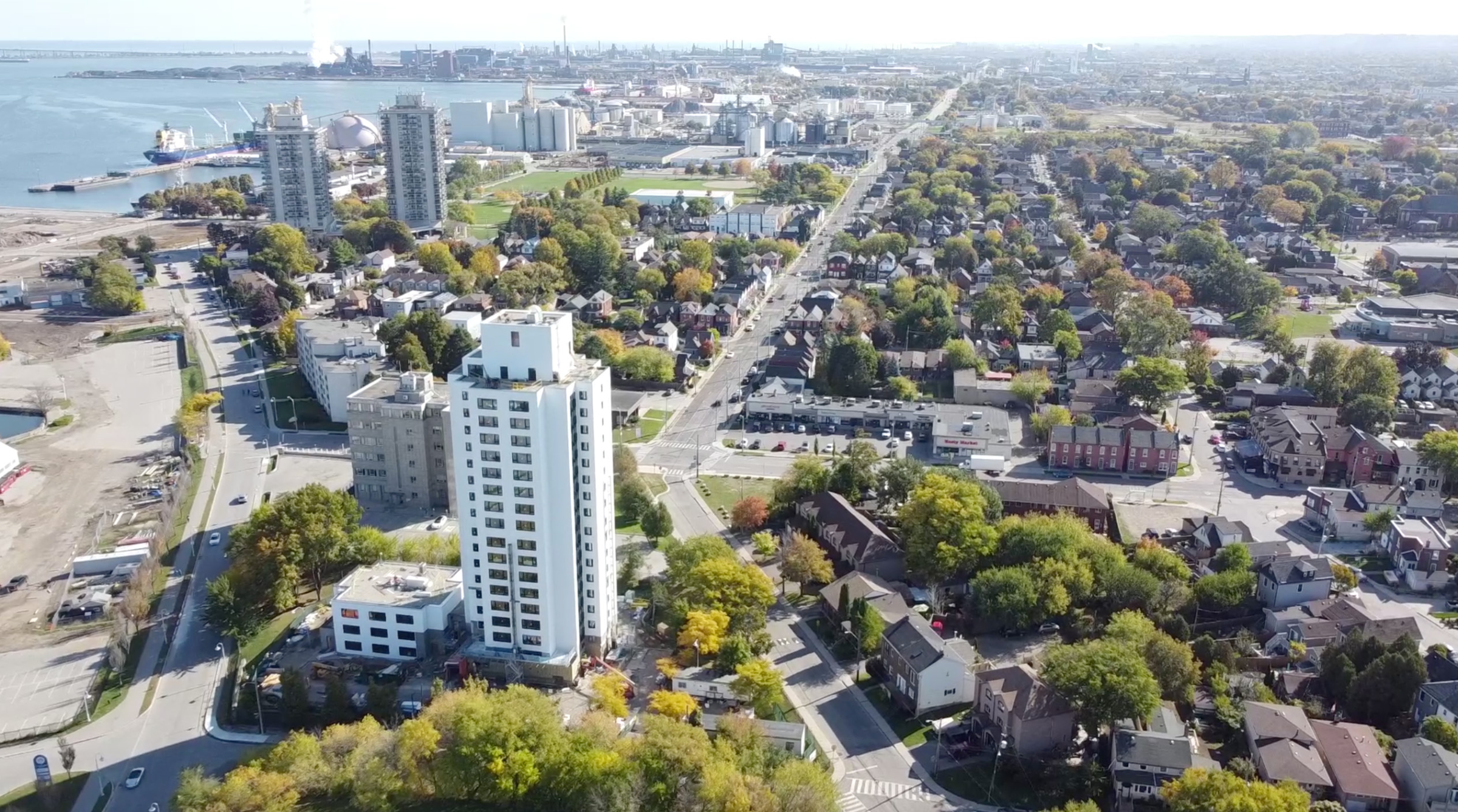Can deep energy retrofits lead to decarbonization? The short answer is yes. But don’t just take my word for it. There is plenty of evidence to support this position. Let’s take a closer look.
According to C40 Cities, urban communities account for nearly 70% of the world’s energy consumption and CO2 emissions. While new building construction today is more likely to incorporate an energy-efficient strategy from the outset, the real opportunity lies in deep energy retrofits of the aging building stock. C40 also asserts that energy renovations can provide up to 55% of the GHG emissions reduction needed to reach the 2030 targets set by the Paris Agreement and align with a 1.5 ̊C trajectory.

Image courtesy of ROCKWOOL North America
Where once the push for decarbonization came from environmental activists and a handful of policymakers, today there is a swell of public support for action. The trend is confirmed in a report released late in 2021 by ROCKWOOL Group and Cambridge Econometrics. The report maps a clear path to greener buildings and shows strong support from the public to renovate their homes if adequate financial and administrative support is available. A global, first-of-its-kind survey of 14,000 people in the US, Denmark, France, Germany, Italy, Poland, and the UK, also confirms the public appetite for energy-efficient buildings, while showcasing the need for governments to develop fit-for-purpose renovation programs.
The polling by OnePoll shows eight of 10 people—or 79%—would renovate their home, given the right assistance. In an even stronger show of support for greening the built environment, 73% believe energy efficiency improvements should be mandatory, provided financial and administrative support is available. 62% believe it is their social responsibility to make their homes climate-friendly, given the same support is available.
ROCKWOOL is proud to be a part of the solution, both in terms of its own operations as well as the sustainable materials it produces for the construction industry.
The Building Envelope is Key

Photo courtesy of ERA Architects
There is a lot of talk among conservationists and sustainability advocates about tapping into cleaner energy sources as well as smart technology to help reduce the carbon emissions from building stock. We love a holistic approach to battling climate change, but all the clean energy and smart technology in the world aren’t going to solve the problem of reducing emissions if buildings are leaky and wasting energy.
Thankfully, architects, builders, and policymakers are recognizing the importance of the building envelope in the equation, both for new builds and retrofits, with improvements to energy codes as well as the materials and strategies used in their construction.
The building envelope affects approximately 50% of the energy demand of typical buildings. Therefore, implementing envelope-related energy conservation methods (ECM) are an effective way to reduce energy demand and operational carbon emissions of a building.
What to Consider in a Retrofit Plan

Photo courtesy of ERA Architects
When deciding on enclosure-specific ECMs, consideration for thermal efficiency, durability, structural capacity, and constructability, among others, is necessary. Understanding the unique challenges of different building envelope retrofit options is critical to ensure appropriate solutions are applied. Let’s dive deeper into what that looks like.
Thermal efficiency
Existing buildings—whether commercial, institutional, or residential—will typically have little to no insulation within the envelope, resulting in excess heat loss and increased energy consumption. More importantly, they usually have poorly installed or non-existent air barriers, making them very leaky and further increasing energy waste.
The addition of insulation in exterior walls and roofs, combined with an appropriate air barrier system, is integral to improving building performance, reducing leaks, and creating more comfortable indoor environments.
When it comes to the assembly’s thermal efficiency, we must consider the system’s overall effective thermal performance, not merely the insulation layer’s nominal thermal resistance. This means accounting for the thermal resistance of all applicable layers within the assembly and calculating reductions caused by thermal bridges.
Durability
One of the critical benefits of retrofitting buildings is that we can increase their lifespan. The added longevity and durability of an envelope and the energy savings they create are a way to justify the upfront costs.
Considerations for an enclosure’s durability include assessing the primary control layers, in particular those related to water and moisture management. It is critical to ensure that appropriate drainage and drying measures, and vapor diffusion control considerations are in place, as poorly designed retrofits may lead to unintended moisture damage.
Constructability
Simply put, a retrofit strategy’s constructability relates to how simple it is to install and execute as well as the overall cost. In practice, each retrofit is unique, with no one approach to rule them all. Upgrading the building envelope can introduce different constructability challenges, depending on the building site and existing condition. The strategies applied will vary and cannot necessarily be used on all projects in the same manner. One common thread that does connect all projects, however, is people. Therefore, an effective strategy must also consider the impact on occupants.
Aesthetics
While very subjective, a building’s aesthetics is often a primary concern for the architect, building owner, and occupant. For existing buildings, the retrofit strategy may require the aesthetics of the facade to be altered or left untouched altogether. With more product options available for meeting retrofit goals, including ROCKWOOL stone wool batts and rigid insulation boards for both interior and exterior applications, increasing a building’s aesthetic design doesn’t always have to be sacrificed for performance.
Though energy conservation is the primary driver for most large-scale retrofits today, there will be some other consistent criteria that should be considered in different types of commercial retrofits. Below are some considerations for different building types.
Office buildings: Evidence shows that an office building’s indoor environmental quality (just like office ergonomics) will impact the long-term health and performance of employees. Controlling noise with a proper acoustical insulation plan will protect their health and improve productivity.
Schools: Student performance is also closely linked to the building’s indoor environment. Receiving natural light during the day will help students sleep better at night, and while colder environments tend to improve concentration, once it exceeds a comfortable level, it will create a negative effect on student performance. Noise reduction is also beneficial for learning as well.
Hotels: A positive guest experience can rely as much on physical comfort and noise control—both in guest rooms as well as common areas—as it does on the building’s aesthetics. If the design is an important criterion in a hotel’s retrofit, it need not be sacrificed for the sake of thermal or sound performance by the building envelope—new solutions in stone wool insulation products can satisfy both requirements.
Materials Count

Photo courtesy of ROCKWOOL North America
Stone wool insulation solutions (batt, semi-rigid, and rigid board for continuous insulation) are an ideal option for myriad reasons, including the most obvious one—superior performance in improving thermal efficiency. Buildings with stone wool insulation can see up to 70% reduction in heating and cooling costs. Beyond that, the other benefits of specifying stone wool insulation for the building envelope include greater protection from fire, noise, and moisture, each of which can adversely affect the integrity of the building’s structure and long-term durability as well as the health and well-being of its occupants.
Why stone wool over other insulation materials? It’s right there in the name. Our products are made from stone, the most abundant natural resource on earth, and fully recyclable. You might hear us talk about harnessing the natural power of stone, that’s because our stone wool insulation solutions carry many of the same properties as the raw material. They are lasting, durable, and resilient.
Ken Soble Tower

Photo courtesy of ERA Architects
I encourage you to read about the deep energy retrofit of Ken Soble Tower in 2021. The multi-unit residential building was completely upgraded, inside and out, to achieve Passive House standard, reducing greenhouse gas emissions by an impressive 94%.
After learning what would be possible with ROCKWOOL’s stone wool insulation solutions, the architects completely changed the original plan for the building envelope. The resulting cladding design included a 6-inch thick stone wool EIFS system that helped them meet the steep targets of the retrofit.
Yes, Ken Soble Tower is a great case study on the benefits of stone wool, but really it should be seen as a shining example of what’s possible in our efforts to meet the essential need for GHG reductions.
Plan a Retrofit
There is a lot to know, way more than we can fit into a single column such as this. Still need convincing? There’s a business case to be made for retrofits, beyond the global climate benefits. Made your decision but not sure where to start? We can help with that, too. Or maybe you’re at the stage where you need technical support in planning specific assemblies? ROCKWOOL is ready to help you plan your next retrofit project in whatever capacity you need.


